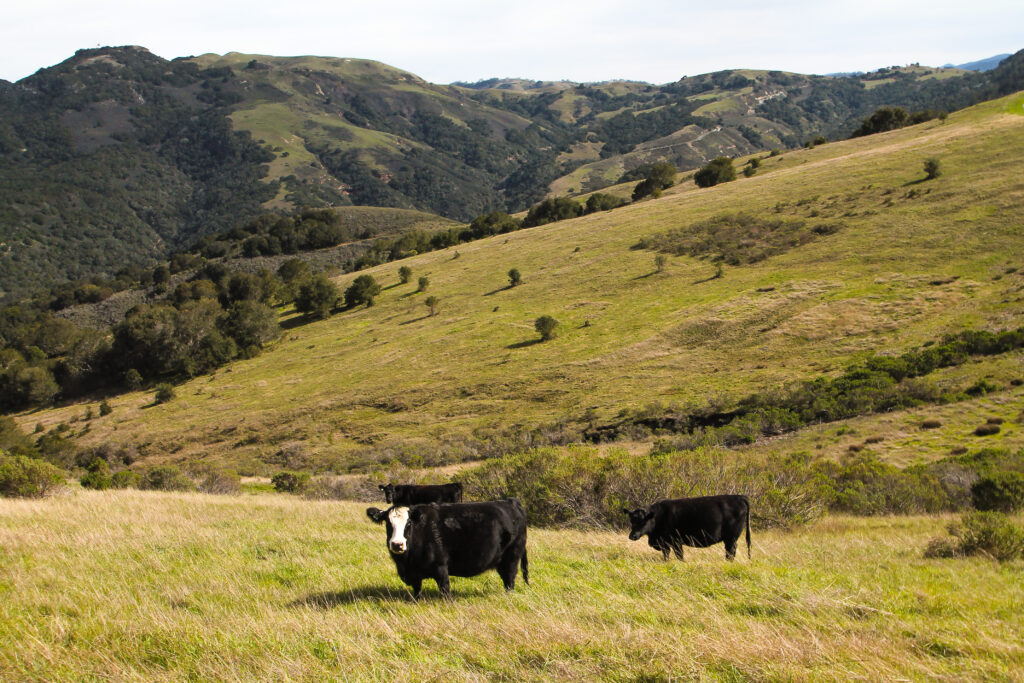
Grazing as a Tool for California Grassland Conservation: SLC’s Eight-year Study Published in Journal of Applied Vegetation Science
Cattle graze in the foreground, Mesa study plot in the background on the right. Photo by Alix Soliman.
July 19, 2023
By Alix Soliman, Communications & Outreach Coordinator
We’re thrilled to announce that the Santa Lucia Conservancy’s eight-year study of livestock grazing as a tool for conservation in California’s coastal grasslands has been published in Applied Vegetation Science. Grasslands cover roughly 25% of the state’s land and thrive with disturbance, both from fire and herbivory. Across California, livestock grazing has been expanding as a land management tool for conservation and fuel reduction, promoted for its potential to simulate disturbance caused by displaced native grazers such as tule elk.
Attempts to investigate the impacts of grazing on California plant communities have produced mixed results, with some studies showing negative effects and others displaying neutral or positive results. Interpreting the environmental impact is made more difficult when practitioners do not distinguish between rotational and year-round stocking, studies are too brief to capture climate and plant variability, and the goals of the grazing managers are unclear. In 2013, the Conservancy reintroduced cattle grazing to The Santa Lucia Preserve in order to test how cattle grazing affects California grasslands over the long-term.
“This work provides important, new information on the effectiveness of cattle grazing as a conservation tool in California’s coastal grasslands,” said SLC’s Executive Director Jamison Watts. “Targeted grazing can be an appropriate tool to accomplish conservation goals, including biomass management and canopy clearing, while improving native annual forbs without risk to native species as a whole.”
Founded in 1995 to protect and steward the unique natural, cultural, and aesthetic resources of the Santa Lucia Preserve, the Conservancy rotates a resident herd of 120 cattle across 2,800 acres of grasslands. With a goal to use medium-to-high intensity grazing, cattle consume or trample up to 80% of the plant material in each pasture. Pastures are delineated by a temporary, single-wire electric fence and grazed on an 18-month rotation, with an average rest period of 486 days. Due to the habitat mosaic of The Preserve, pasture sizes vary from one to 340 acres, and the size of the herd and days spent grazing are calibrated to the amount of forage available.
From 2015 through 2022, species richness, percent cover, and all species present were monitored annually across 17 study sites. Our study found that this method of targeted grazing on the Santa Lucia Preserve decreased thatch depth by 3.5 centimeters, decreased thatch cover by 12%, increased cover of native annual forbs by 1.2%, increased bare ground cover by 2.8%, and had no significant influence on either native or non-native plant diversity.
“California is very different from the rest of the country because it has abundant annual grasses, whereas most of this type of grazing research is occurring in perennial grasslands of the Midwest,” said David Toledo, Research Rangeland Management Specialist for the USDA Agricultural Research Service. “Long-term datasets such as this one are hard to find. These data and research contribute to broader national efforts to build state and transition models and ecological site descriptions, which are tools used to guide land management decisions. Eight years of data on California’s coastal grassland ecosystem is a great treasure — it’s remarkably uncommon.”
“Our data show that cattle can be used as a disturbance force without adversely affecting the species composition of our grasslands and prairies,” said Conservation Grazing Manager Claudio Núñez. “Furthermore, this study suggests that carefully managed cattle may be able to build favorable conditions for native plants.”
While more widespread, long-term studies are needed to support this research, we are proud to share that SLC’s implementation of a conservation-directed grazing regime has successfully achieved fuel management goals without impeding native biodiversity.
Please contact Conservation Grazing Manager Claudio Núñez at (831) 238-4342 or [email protected] with questions about this research or grazing practices on The Santa Lucia Preserve.